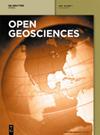Predicting copper-polymetallic deposits in Kalatag using the weight of evidence model and novel data sources
IF 1.3
4区 地球科学
Q3 GEOSCIENCES, MULTIDISCIPLINARY
引用次数: 0
Abstract
The Kalatag Ore Cluster Area, located in the Eastern Tianshan metallogenic belt of Xinjiang, stands out as a notable copper polymetallic mineralization zone, recognized for its diverse ore types and untapped potential. Despite the foundational nature of traditional exploration methods, they have not fully exploited this potential. Addressing this, our study leverages modern geospatial technologies, especially ArcGIS, combined with multi-source geoscience data to refine ore formation predictions in Kalatag. We identified key ore-controlling factors: the ore-bearing strata of Daliugou and Dananhu Groups, buffer zones around faults and intrusions, and geophysical anomalies. From these, a conceptual model was developed using the weight of evidence model. This model pinpointed four ‘A’ class and three ‘B’ class targets for mineral exploration, highlighting the central role of faults in ore control. Significantly, all known ore deposits were encompassed within these targets. Our approach not only paves the way for improved ore prediction in Kalatag but also offers a blueprint for other mineral-rich areas. Merging traditional geology with advanced technology, we elevate mineral exploration’s precision, emphasizing the synergy of an integrated method, especially in geologically complex areas. The effectiveness of our model provides insights for future exploration, particularly in mining areas’ deeper zones.利用证据权重模型和新数据源预测卡拉塔格的铜多金属矿床
卡拉塔格矿群区位于新疆东天山成矿带,是一个著名的铜多金属成矿带,其矿石类型多样,潜力尚未开发。尽管传统勘探方法具有基础性,但并未充分挖掘出这一潜力。针对这一问题,我们的研究利用现代地理空间技术,尤其是 ArcGIS,结合多源地球科学数据,对卡拉塔格的成矿预测进行了改进。我们确定了关键的矿石控制因素:大柳沟组和大南湖组的含矿地层、断层和侵入体周围的缓冲区以及地球物理异常。在此基础上,利用证据权重模型建立了一个概念模型。该模型确定了四个 "A "级和三个 "B "级矿产勘探目标,突出了断层在矿石控制中的核心作用。重要的是,所有已知矿床都包含在这些目标中。我们的方法不仅为改进卡拉塔格的矿石预测铺平了道路,也为其他矿产资源丰富的地区提供了蓝图。我们将传统地质学与先进技术相结合,提高了矿产勘探的精确度,强调了综合方法的协同作用,尤其是在地质复杂的地区。我们模型的有效性为未来的勘探,尤其是矿区深部的勘探提供了启示。
本文章由计算机程序翻译,如有差异,请以英文原文为准。
求助全文
约1分钟内获得全文
求助全文
来源期刊

Open Geosciences
GEOSCIENCES, MULTIDISCIPLINARY-
CiteScore
3.10
自引率
10.00%
发文量
63
审稿时长
15 weeks
期刊介绍:
Open Geosciences (formerly Central European Journal of Geosciences - CEJG) is an open access, peer-reviewed journal publishing original research results from all fields of Earth Sciences such as: Atmospheric Sciences, Geology, Geophysics, Geography, Oceanography and Hydrology, Glaciology, Speleology, Volcanology, Soil Science, Palaeoecology, Geotourism, Geoinformatics, Geostatistics.
 求助内容:
求助内容: 应助结果提醒方式:
应助结果提醒方式:


